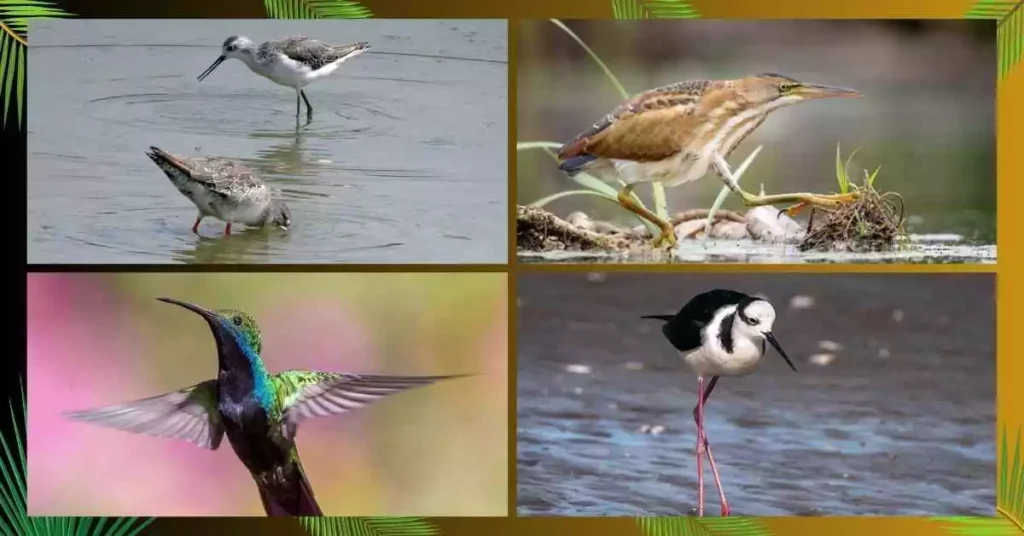Are you curious to know about small birds with long necks? Look no further than these top 7 unique and interesting birds.
Did you know that the Least Bittern is a shy and elusive bird that is rarely seen in the open? Or that the Common Gallinule has a distinctive red bill and a loud, clucking call?
And let’s not forget about the Black-necked Stilt, with its striking black and white plumage and long, thin legs. These birds can be found throughout North and South America, in a variety of wetland habitats.
Discover the top 7 small birds with long necks, including the Hummingbird, Spotted Sandpiper, Solitary Sandpiper, and Wilson’s Snipe. Learn about their habitats, behavior, and unique features.
Hummingbirds
Hummingbirds, found from Alaska to Tierra Del Fuego, are mostly in the Americas. With over 300 species, they range from the smallest (bee hummingbird at 2.6 grams) to the largest (giant hummingbird at 24 grams).
One unique feature of hummingbirds is their ability to hover in mid-air. They can also fly backward and upside down. Known for their colorful feathers, the colors can change depending on the angle of the light. Males have more vibrant colors to attract mates during the breeding season. Hummingbirds love to eat nectar from flowers and also consume small insects like mosquitoes and fruit flies for protein.
Spotted Sandpiper
The Spotted Sandpiper is found in North and Central America. It has a spotted pattern on its chest and belly, known for its bobbing tail and erratic flight pattern. As a migratory bird, it spends its breeding season in northern regions and its non-breeding season in southern areas. It feeds on small aquatic insects and crustaceans.
Solitary Sandpiper
This small sandpiper is found across North and South America. It looks similar to the Spotted Sandpiper but lacks the spotted pattern on its chest and belly. Named for its solitary nature, it can also be seen in small groups. The Solitary Sandpiper breeds in northern regions and winters in the southern United States, Central America, and South America, feeding on small aquatic animals, including insects, crustaceans, and small fish.
Least Bittern
The Least Bittern, a small heron, is found in wetlands throughout North and South America. It has a long neck, often held in an S-shaped curve, and is known for its camouflaged plumage. The Least Bittern is a shy bird that is rarely seen in the open, preferring to eat small fish, amphibians, and insects by standing still and waiting for prey to come within striking distance.
Common Gallinule
Also known as the Common Moorhen, the Common Gallinule is a small waterbird with a red bill and long neck. Found throughout the Americas, it is known for its loud, clucking call. It inhabits various wetland habitats, including marshes, swamps, and ponds. The Common Gallinule feeds on a variety of aquatic plants and animals, including seeds, insects, and small fish.
Black-necked Stilt
The Black-necked Stilt is a striking bird with long, thin legs, and a long, thin neck used to feed on small aquatic animals. Found throughout North and South America, it is known for its distinctive black and white plumage. The Black-necked Stilt inhabits various wetland habitats, including salt ponds, marshes, and mudflats, and feeds on small aquatic animals, including insects, crustaceans, and small fish.
Wilson’s Snipe
Wilson’s Snipe is a small wading bird found across North and South America. It has a long, straight bill and a long neck used to probe for food in wetlands and marshes. Known for its distinctive “winnowing” call during courtship displays, the Wilson’s Snipe is a migratory bird that breeds in northern regions and winters in the southern United States, Central America, and South America. It feeds on a variety of small aquatic animals, including insects, worms, and small crustaceans.
Conclusion
In summary, small birds with long necks are tiny but mighty when it comes to their personalities. These birds have fascinating features and habits that provide a glimpse into the natural world. Whether you’re an avid birdwatcher or just starting, these top 7 small birds with long necks are sure to delight and inspire you. Keep an eye out for these feathered friends on your next outdoor adventure and get ready to be amazed.

